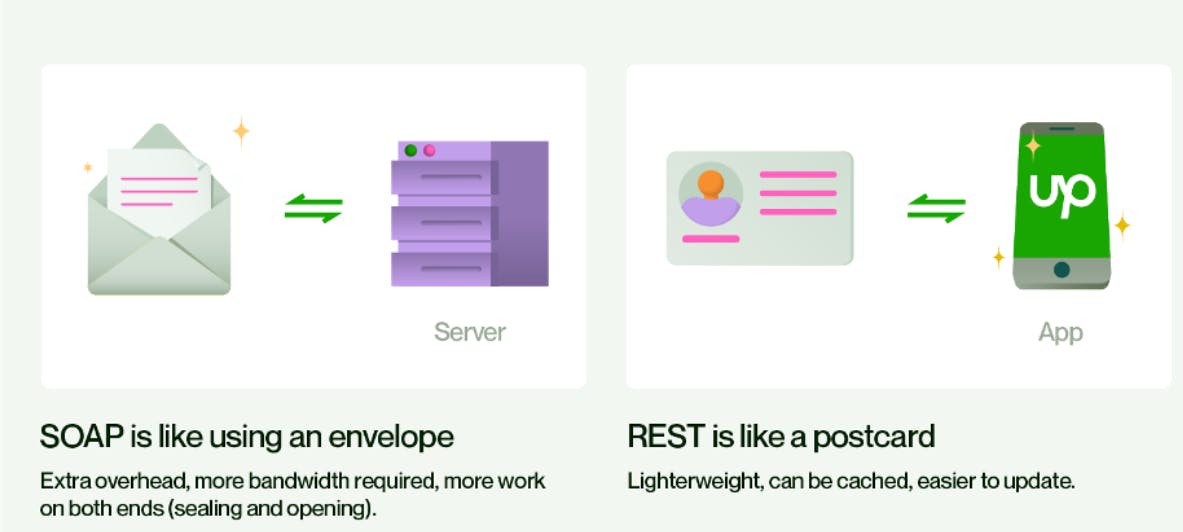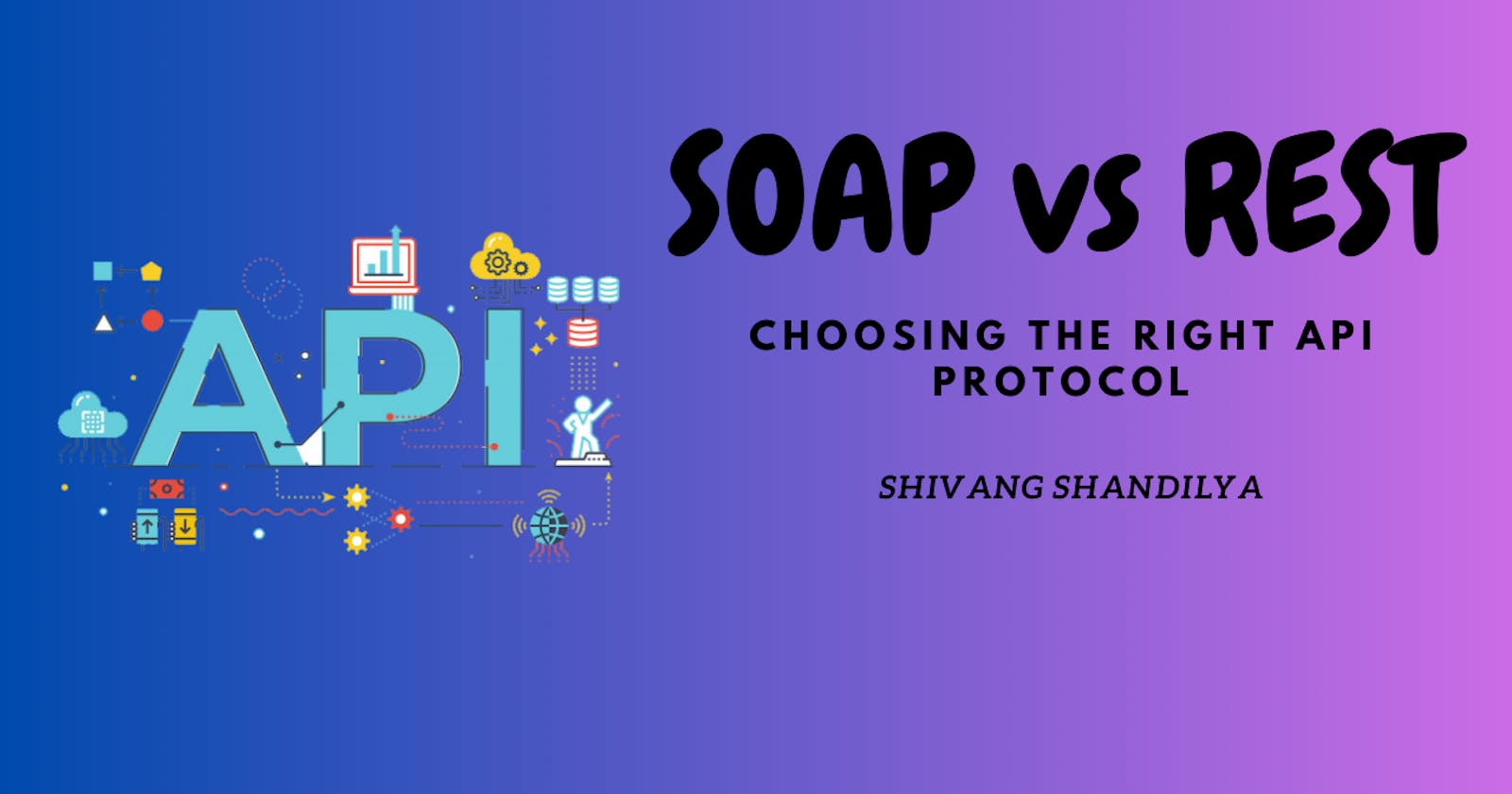Table of contents
- What is API?
- What is SOAP?
- What is a REST API?
- SOAP vs. REST: The key differences
- Which API should you choose for your project?
- Conclusion
- FAQs
What is API?
So let's first take a look at what API is all about. So an API, which stands for Application Programming Interface, is like a messenger that allows different software applications to talk to each other and share information or functionality.
Now that you got an idea of what an API is all about, let's come to the topic on which our blog is about.
What is SOAP?
SOAP, which stands for Simple Object Access Protocol, is a protocol used for communication between applications over a network. It provides a standardized way for software applications to exchange structured information in a format that can be understood by different systems and programming languages.
SOAP uses XML (eXtensible Markup Language) as its message format. XML provides a structured way to represent data, similar to how HTML is used to structure web pages. SOAP messages consist of an XML envelope that contains the actual data being sent or requested.
Reasons you may want to develop an application with a SOAP API include higher levels of security (e.g., a mobile application interfacing with a bank), messaging apps that need reliable communication, or ACID compliance.
Let's explore an illustration of SOAP
Using SOAP, the request to the API is an HTTP POST request with an XML request body. The request body consists of an envelope which is a type of SOAP wrapper that identifies the requested API, and a SOAP body that holds the request parameters. In this case, we want to fetch the user with the name “Shivang.”
<soapenv:Envelope xmlns:soapenv="http://schemas.xmlsoap.org/soap/envelope/" xmlns:sch="http://www.soapexample.com/xml/users">
<soapenv:Header/>
<soapenv:Body>
<sch:UserDetailsRequest>
<sch:name>Shivang</sch:name>
</sch:UserDetailsRequest>
</soapenv:Body>
</soapenv:Envelope>
The response, just like the request, consists of a SOAP envelope and a SOAP body. In this case, the SOAP body represents the requested user data.
<soapenv:Envelope xmlns:soapenv="http://schemas.xmlsoap.org/soap/envelope/">
<soapenv:Header/>
<soapenv:Body>
<ns2:UserDetailsResponse xmlns:ns2="http://www.soapexample.com/xml/users">
<ns2:User>
<ns2:name>Shivang</ns2:name>
<ns2:age>5</ns2:age>
<ns2:address>New Delhi</ns2:address>
</ns2:User
</ns2:UserDetailsResponse>
</soapenv:Body>
</soapenv:Envelope>
What is a REST API?
REST, which stands for Representational State Transfer, is an architectural style and set of principles used for designing web services. It provides a simple and lightweight way for applications to communicate and exchange data over the Internet.
REST APIs use the existing HTTP protocol, which is the foundation of the World Wide Web. This means that REST leverages the standard HTTP methods like GET, POST, PUT, DELETE, etc., to perform different actions on resources.
Reasons you may want to build an API to be RESTful include resource limitations, fewer security requirements, browser client compatibility, discoverability, data health, and scalability—things that really apply to web services.
Let's explore an illustration of REST
REST APIs can be called with all of the HTTP verbs. To get a resource, in this case, a user, a GET request is used. While the SOAP request holds the user’s name in the body, a REST API accepts GET parameters from the URI.
Now let's use the above example that we applied using SOAP protocol here using REST protocol.
GET restexample.com/users?name=Shivang
As mentioned, REST APIs typically use the data format JSON. The user is represented in JSON like this:
{
"name": "Shivang",
"age": 5,
"address": "New Delhi"
}
SOAP vs. REST: The key differences

Communication: SOAP uses XML for communication, while REST uses lightweight data formats such as JSON or XML.
Protocol: SOAP relies on protocols such as HTTP, SMTP, or TCP for communication, while REST primarily uses HTTP.
Complexity: SOAP is considered more complex due to its extensive specification, whereas REST is simpler and easier to understand.
Statelessness: REST is stateless, meaning each request is independent and contains all the necessary information, while SOAP can maintain the state between requests.
Flexibility: REST allows flexibility in choosing data formats and supports various data exchange patterns, while SOAP has a predefined message structure.
Performance: REST is generally considered faster and more efficient than SOAP due to its lightweight nature and caching capabilities.
Which API should you choose for your project?
For the most part, when it comes to APIs for web services, developers tend toward a RESTful architecture unless the SOAP path is clearly a better choice, say for an enterprise app that’s backed by more resources, needs super-tight security, and has more requirements.
Factors to Consider when Choosing:
Project Requirements: Consider the specific requirements of your project, such as security, interoperability, performance, and simplicity.
Ecosystem: Assess the existing systems and frameworks in your ecosystem to determine which protocol aligns best with your infrastructure and tools.
Team Expertise: Consider the expertise and familiarity of your development team with SOAP and REST to ensure efficient implementation.
So which API do I use?
Adopting REST API has revolutionized my work and significantly improved my productivity compared to SOAP API. The flexibility and simplicity offered by REST have streamlined my development process and enhanced the efficiency of my applications. REST's stateless nature allows for lightweight and scalable systems, reducing development time and enabling faster deployment. REST API has proven to be a game-changer, empowering me to develop decoupled and modular systems that easily adapt to changing business requirements.
Conclusion
Regardless of the technology you choose, the key to building a successful API lies in designing it with best practices in mind. A well-designed API should be intuitive, easy to use, and easy to understand for developers and clients alike. By focusing on clarity, flexibility, and scalability, you can significantly accelerate development, improve integration with other systems, and ensure your API remains adaptable to future needs.
FAQs
What is the main difference between SOAP and REST APIs?
SOAP is a protocol that uses XML exclusively for its messaging format, offering strong standards and built-in security. REST, on the other hand, is an architectural style that leverages HTTP methods and supports multiple data formats like JSON and XML, making it lightweight and faster.
Which API type is better for mobile app development?
REST is typically preferred for mobile app development due to its simplicity, lightweight nature, and JSON support, which is easily handled by modern mobile platforms. SOAP may still be used in scenarios requiring higher security and reliability.
What are some common tools for API testing SOAP and REST APIs?
Popular tools for API testing include:
Keploy: An open-source testing tool that auto-generates test cases from real API traffic, making API testing faster and easier. It supports testing REST and SOAP APIs with minimal manual effort.
Postman: For testing REST APIs with a user-friendly interface.
SoapUI: For comprehensive SOAP and REST API testing.
Katalon Studio: A robust platform for automated API testing.
Is API testing different for SOAP and REST APIs?
Yes, API testing for SOAP focuses on validating the XML structure, SOAP envelopes, and WSDL files, while REST API testing involves verifying HTTP methods, endpoints, and responses (typically in JSON format). However, both require verifying functionality, performance, and security.
When should I choose SOAP over REST for my API?
SOAP is ideal for use cases that demand:
High security (e.g., banking and financial applications).
ACID compliance for reliable transactions.
Legacy system integration where SOAP standards are already in place.

